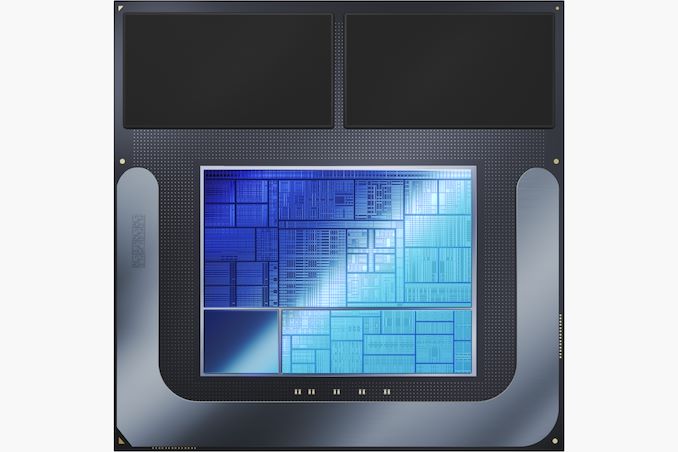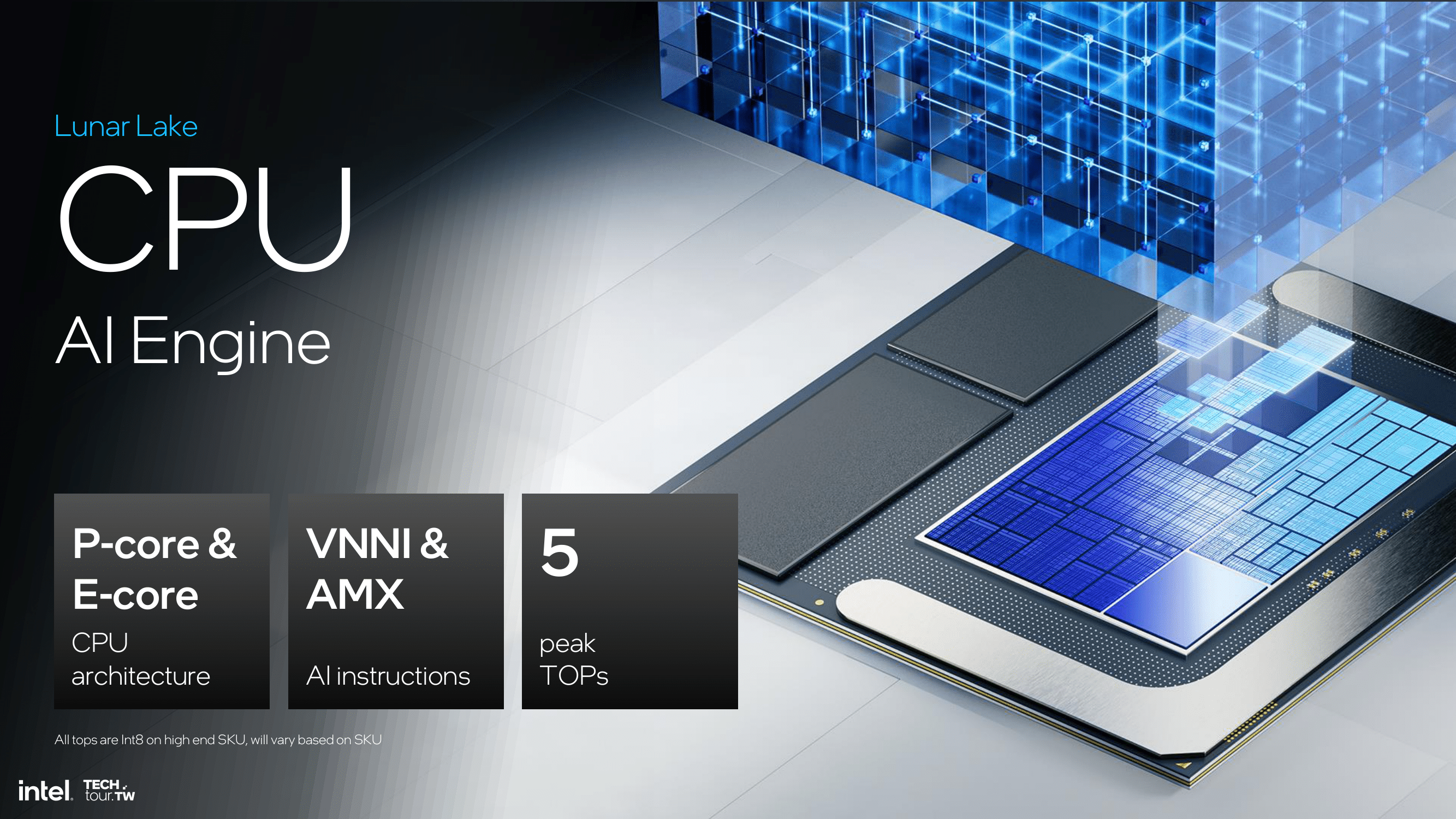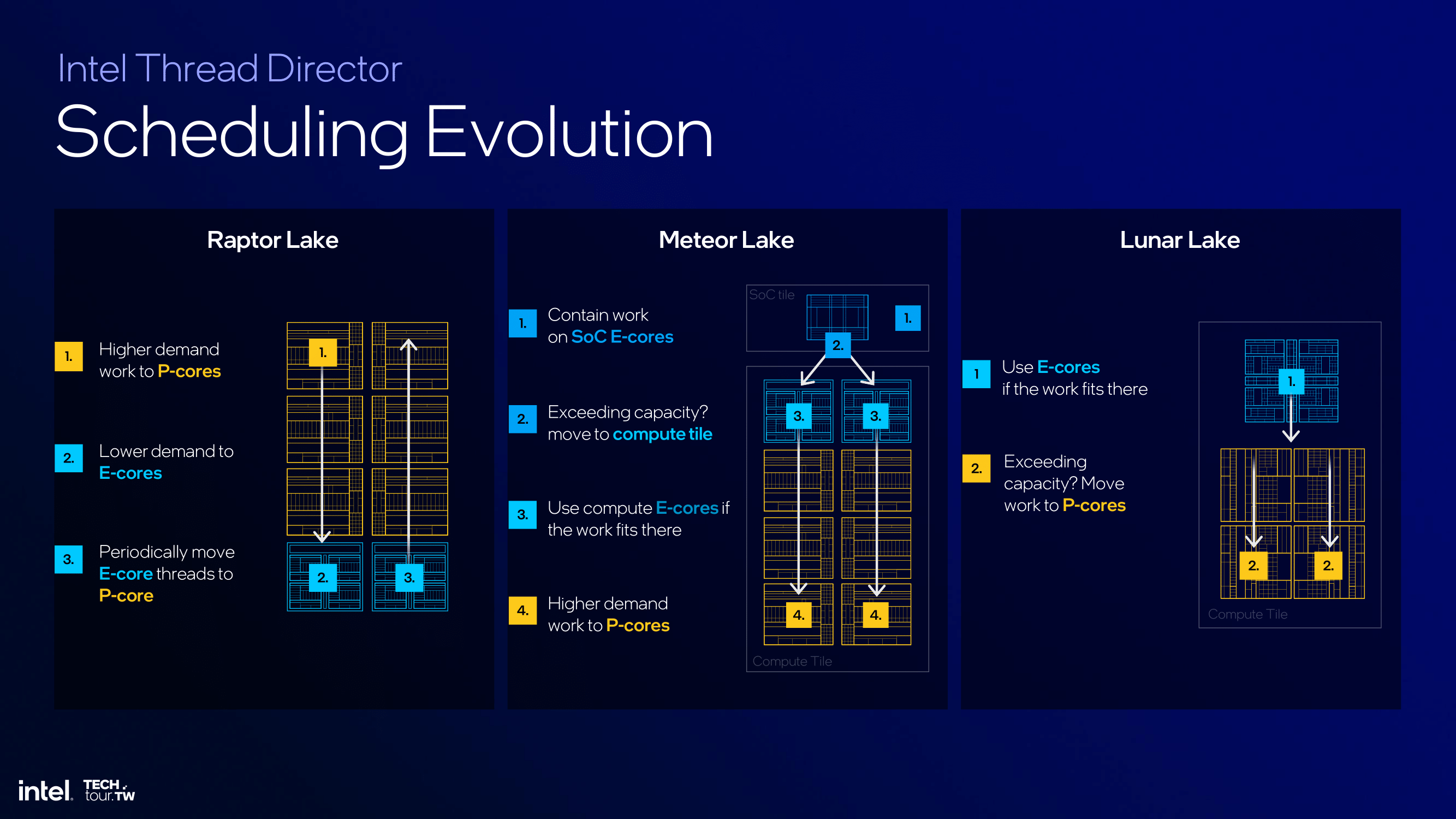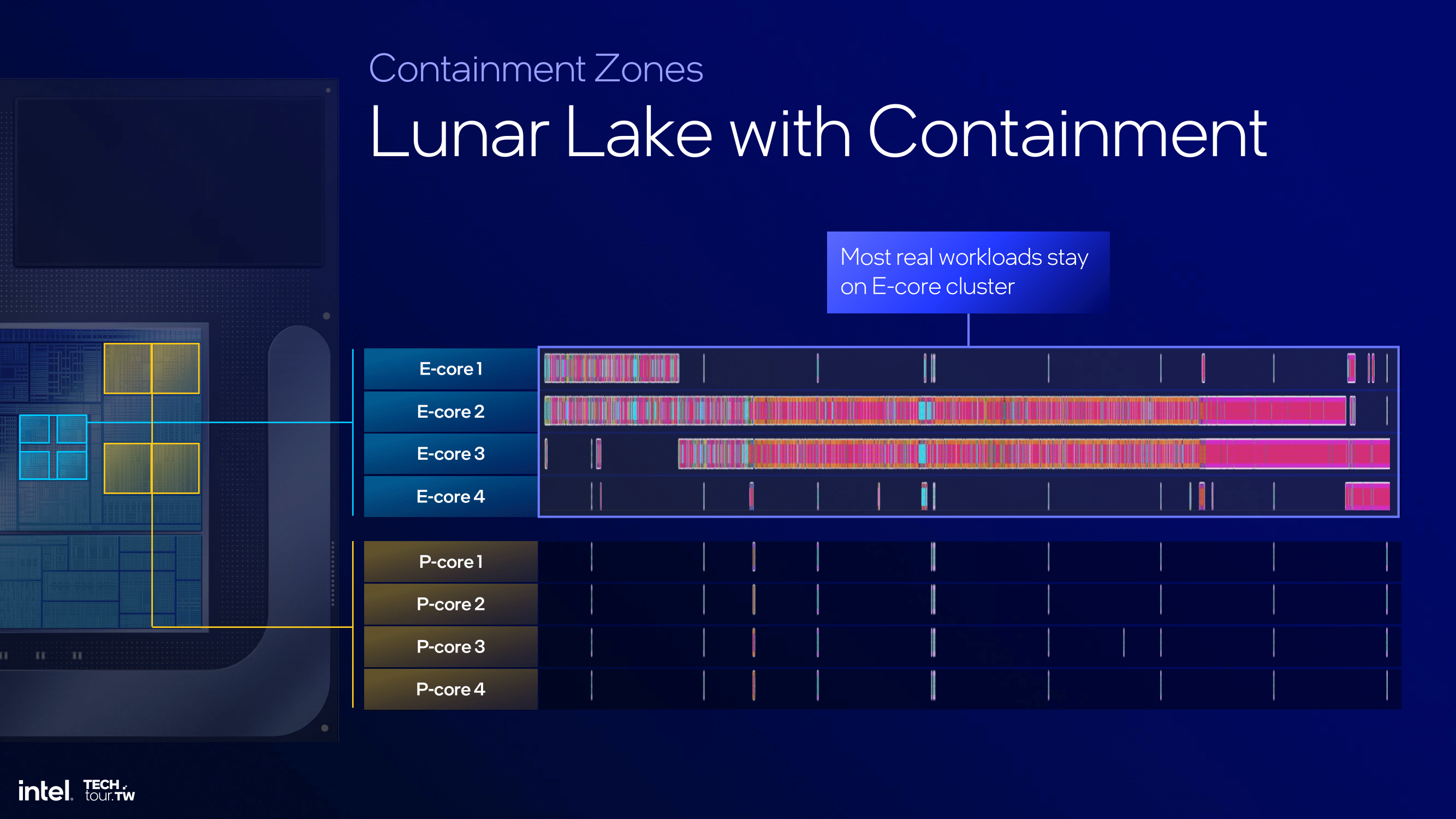Intel Unveils Lunar Lake Architecture: New P and E cores, Xe2-LPG Graphics, New NPU 4 Brings More AI Performance
by Gavin Bonshor on June 3, 2024 11:00 PM EST
Intel this morning is lifting the lid on some of the finer architectural and technical details about its upcoming Lunar Lake SoC – the chip that will be the next generation of Core Ultra mobile processors. Once again holding one of their increasingly regular Tech Tour events for media and analysts, Intel this time set up shop in Taipei just before the beginning of Computex 2024. During the Tech Tour, Intel disclosed numerous facets of Lunar Lake, including their new P-Core design codenamed Lion Cove and a new wave of E-cores that are a bit more like Meteor Lake's pioneering Low Power Island E-Cores. Also disclosed was the Intel NPU 4, which Intel claims delivers up to 48 TOPS, surpassing Microsoft's Copilot+ requirements for the new age of AI PCs.
Intel's Lunar Lake represents a strategic evolution in their mobile SoC lineup, building on their Meteor Lake launch last year, focusing on enhancing power efficiency and optimizing performance across the board. Lunar Lake dynamically allocates tasks to efficient cores (E-cores) or performance cores (P-cores) based on workload demands by leveraging advanced scheduling mechanisms, which are assigned to ensure optimal power usage and performance. Still, once again, Intel Thread Director, along with Windows 11, plays a pivotal role in this process, guiding the OS scheduler to make real-time adjustments that balance efficiency with computational power depending on the intensity of the workload.
| Intel CPU Architecture Generations | |||||
| Alder/Raptor Lake | Meteor Lake |
Lunar Lake |
Arrow Lake |
Panther Lake |
|
| P-Core Architecture | Golden Cove/ Raptor Cove |
Redwood Cove | Lion Cove | Lion Cove | Cougar Cove? |
| E-Core Architecture | Gracemont | Crestmont | Skymont | Crestmont? | Darkmont? |
| GPU Architecture | Xe-LP | Xe-LPG | Xe2 | Xe2? | ? |
| NPU Architecture | N/A | NPU 3720 | NPU 4 | ? | ? |
| Active Tiles | 1 (Monolithic) | 4 | 2 | 4? | ? |
| Manufacturing Processes | Intel 7 | Intel 4 + TSMC N6 + TSMC N5 | TSMC N3B + TSMC N6 | Intel 20A + More | Intel 18A |
| Segment | Mobile + Desktop | Mobile | LP Mobile | HP Mobile + Desktop | Mobile? |
| Release Date (OEM) | Q4'2021 | Q4'2023 | Q3'2024 | Q4'2024 | 2025 |
Lunar Lake: Designed By Intel, Built By TSMC (& Assembled By Intel)
While there are many aspects of Lunar Lake to dive into, perhaps it's best we start with what's sure to be the most eye-catching: who's building it.
Intel's Lunar Lake tiles are not being fabbed using any of their own foundry facilities – a sharp departure from historical precedence, and even the recent Meteor Lake, where the compute tile was made using the Intel 4 process. Instead, both tiles of the disaggregated Lunar Lake are being fabbed over at TSMC, using a mix of TSMC's N3B and N6 processes. In 2021 Intel set about freeing their chip design groups to use the best foundry they could – be it internal or external – and there's no place that's more apparent than here.
Overall, Lunar Lake represents their second generation of disaggregated SoC architecture for the mobile market, replacing the Meteor Lake architecture in the lower-end space. At this time, Intel has disclosed that it uses a 4P+4E (8 core) design, with hyper-threading/SMT disabled, so the total thread count supported by the processor is simply the number of CPU cores, e.g., 4P+4E/8T.
The build-up of Lunar Lake combines a synergetic collaboration between Intel’s architectural design team and TSMC's manufacturing process nodes to bring the latest Lion Cove P-cores to Lunar Lake, which boosts Intel's architectural IPC as you would expect from a new generation. At the same time, Intel also introduces the Skymont E-cores, which replace the Low Power Island Cresmont E-cores of Meteor Lake. Notably, however, these E-cores don't connect to the ring bus like the P-cores, which makes them a sort of hybrid LP E-core, combining the efficiency gains of the more advanced TSMC N3B node with the double-digit gains in IPC over the previous Crestmont cores.
The entire compute tile, including the P and E-cores, is built on TSMC's N3B node, while the SoC tile is made using the TSMC N6 node.
At a higher level, Intel is once again using their Foveros packaging technology here. Both the compute and SoC (now the "Platform Controller") tiles sit on top of a base tile, which provides high-speed/low-power routing between the tiles, and further connectivity to the rest of the chip and beyond.
In another first for a mainstream Intel Core product, the Lunar Lake SoC platform also includes up to 32 GB of LPDDR5X memory on the chip package itself. This is arranged as a pair of 64-bit memory chips, offering a total 128-bit memory interface. As with other vendors using on-package memory, this change means that users can't just upgrade DRAM at-will, and the memory configurations for Lunar Lake will ultimately be determined by what SKUs Intel opts to ship.
With Lunar Lake, Intel is also strongly focusing on AI, as the architecture integrates a new NPU called NPU 4. This NPU is rated for up to 48 TOPS of INT8 performance, thus making it Microsoft Copilot+ AI PC ready. This is the bar all of the PC SoC vendors are aiming for, including AMD and Qualcomm too.
Intel's integrated GPU will also be a contributing player here. While not the highly efficient machine that the dedicated NPU is, the Arc Xe2-LPG brings dozens of additional T(FL)OPS of performance with it, and some additional flexibility an NPU doesn't come with. Which is why you'll also see Intel rating the performance of these chips in terms of total platform TOPS – in this case, 120 TOPS.
Intel's collaboration with Microsoft further enhances workload management through the fabled Intel Thread Director, optimized for applications such as the Copilot assistant. Given the time of the introduction of Lunar Lake, it somewhat sets the stage for a Q3 2024 launch, which coincides with the holiday 2024 market.
Intel Lunar Lake: Updating Intel Thread Director & Power Management Improvements
To say that energy efficiency is a key goal for Lunar Lake would be an understatement. For as much as Intel is riding high in the mobile PC CPU market (AMD's share there is still but a fraction), the company has been feeling the pressure over the last few years from customer-turned-rival Apple, whose M-series Apple Silicon has been setting the bar for power efficiency over the last few years. And now with Qualcomm attempting to do the same things for the Windows ecosystem with their forthcoming Snapdragon X chips, Intel is preparing to make their own power play.
Intel's Thread Director and power management updates for Lunar Lake show various and significant improvements compared to Meteor Lake. The Thread Director uses a heterogeneous scheduling policy, initially assigning tasks to a single E-core and expanding to other E-cores or P-cores as and when needed. OS containment zones are designed to limit tasks to specific cores, which directly improves power efficiency and delivers the performance needed by the right core for the workload at hand. Integration with power management systems and a quad array of Power Management Controllers (PMC) further allows the chip, in concert with Windows 11, to make context-aware adjustments, ensuring optimal performance with minimal power usage and wastage.
Lunar Lake's scheduling strategy effectively handles power-sensitive applications. One example Intel gave is that video conferencing tasks are kept within the efficiency core cluster, utilizing the E-cores to maintain performance while reducing power consumption by up to 35%, as shown by Intel's provided data. These improvements are achieved through collaboration with OS developers such as Microsoft for seamless integration for optimizing for the best balance between power consumption and performance.
Focusing on the power management system for Lunar Lake, Intel uses its SoC power management, operating in efficiency, balance, and performance modes tailored and designed to adapt to whatever the demands of the workload at the time of operation. This multi-layered approach allows the Lunar Lake SoC to operate efficiently. Again, much like the Intel Thread Director, the PMCs can balance power usage with performance needs.
Intel further plans to enhance the Thread Director by increasing scenario granularity, implementing AI-based scheduling hints, and enabling cross-IP scheduling within Windows 11. These enhancements essentially equate to workload management designed to boost overall power efficiency and deliver performance across various applications when needed without wasting power budget by allocating lighter tasks to the higher power P-cores.
Over the next few pages, we'll explore the new P and E cores and Intel's update to ther integrated Arc Xe (Xe2-LPG) graphics.















91 Comments
View All Comments
thestryker - Monday, June 3, 2024 - link
I'm curious what the overall E-core performance is going to look like since the cluster won't have L3 cache access. Chips and Cheese did some analysis of the LP E-cores on MTL and found this specifically to be a big negative. I'm guessing this design is going to be limited to just LNL and is predominantly for the power savings.ET - Tuesday, June 4, 2024 - link
Interestingly, Intel is comparing Skymont to Raptor Cover. I agree that we have to wonder how the L3 (or lack thereof) affect this, but from the Chips and Cheese figures alongside Intel's performance improvement figures, it looks like Skymont without L3 cache will be faster than Crestmont with L3 cache.kwohlt - Tuesday, June 4, 2024 - link
There's 8MB of "SOC cache", separate from both the P and E cores, that should in practice function as the E cores' L3thestryker - Tuesday, June 4, 2024 - link
That's my assumption as well as I think the GPU would be the other part predominantly using it and they shouldn't really both be hitting it at the same time.sharath.naik - Monday, June 10, 2024 - link
Side cache is not the same as L3, or I think they would have called it that. shared L3 is where the memory sync can happen across cores. if not, it needs to go all the way back to ram. So, side caches really cannot be considered as L3, more like expanded L2 for E-core and expanded l3 for P-Core? is my guess. Yes, it means things that run on both E-Core and P-Core, at the same time, will take a hit on performance. I think they were targeting the majority use case. where most won't need more than 4 threads or threads won't be working on the same data.powerarmour - Thursday, June 6, 2024 - link
I can see this being an embarrassing launch if it gets slapped around by Qualcomm's SDx Elitemode_13h - Friday, June 7, 2024 - link
Well, they're on a better node that Qualcomm, so there's that.sharath.naik - Monday, June 10, 2024 - link
It absolutely will. Because this is going to be slower than meteor lake in CPU. Elite is supposed to be 30% faster. Intel should have released 8 P-core version to compete in performance. But I think they wanted to reserve that to be produced on their own fabs.lmcd - Monday, June 17, 2024 - link
Snap Elite is supposed to be 30% faster at essentially-undisclosed power. Lunar Lake will ironically undercut the Snapdragon Elite on power and cost while delivering good performance.Drumsticks - Tuesday, June 4, 2024 - link
I hate to ask this, but was this article fully written by Gavin and proof'ed by another editor? Was there a deadline push to get it out as soon as Intel released the information on Lunar Lake? It just reads so, so disjointed. It feels like there are so many issues in this paragraph alone on the P-core overview; it feels jarring to read."This Lion Cove architecture **also aligns with performance increases**, boasting a predicted double-digit bump in IPC over the older Redwood Cove generation. This uplift is noticed, especially **in the betterment of its hyper-threading, whereby improved IPC** by 30%, dynamic power efficiency improved by 20%, **and previous technologies, in balancing**, without increasing the core area, **in a commitment of Intel to better performance**, within existing physical constraints."
I've seen so much better work from Gavin, and Anandtech in general, that I almost hope that this page was heavily written by software. I know it's a press release, and there's not a whole lot of information, but the level of first party detail here feels similar to the Architecture Day 2021 presentations Intel did on Alder Lake, which got fantastic coverage from Andrei and Dr. Cuttress, and here it feels like we are getting a poorly worded restating of the slides with hardly any analysis or greater than surface level understanding.
I've been reading Anandtech since I was 15, and the level of detail in the Sandy Bridge era articles honestly had a huge influence on my choice to pursue a career in CPU Design. I've mountains of respect for what Anandtech has published in the past, but this article feels rushed.